While Yangon is the biggest city and the gateway of Myanmar, Bagan – 600km away from Yangon - is one of Myanmar’s top destinations, contains most of interesting things of the country that you cannot skip when travelling to Myanmar.
This was the capital of the Pagan dynasty - existed from the 9th to the 13th century – the dynasty that unified Myanmar territory today. Bagan is famous for more than 2,000 large and small temples in an area of about one hundred square kilometers. Being one of the world’s greatest archeological sites that could remind us of Machu Picchu (Peru) or Angkor Wat (Siem Reap – Cambodia) but still keeps its primitive beauty and not yet be affected by commercial and tourism.

Bagan - An eternal ancient soul
Bagan is well known for countless stunning images of temples and towers that submerged in the morning mist and colorful balloons fluttering in sunrise and sunset. The natural framework looks amazing from above. A verdant 26 square-mile plain is partly covered in lush of palm and tamarind, loom in a bend of the lazy-flowing Irrawaddy river and the hazy silver-grey of distant mountains. The temples were built between 1057 and 1287, when the kingdom had to suffer earthquakes and also Kublai khan and his invading Mongols. Nowadays, about 2,230 of 4,450 original temples left. The Buddhists believed that building a temple was earning merit. And they are not only the legacy of the land, but also of the whole country. Most are preserved and recognized as World Heritages by the UNESCO. Many remain ancient frescoes and statues of Buddha. Even though now, more and more tourists come to discover them and the hawkers are beginning to appear, only a handful are regular visited.
Mount Popa is 50 kilometers Southeast of Bagan, offers panoramic views of the surrounding plains from its 1,518m summit. The Popa Taungkalat is a famous and sacred monastery perching dramatically on top a volcanic plug.
The Bagan and Mount Popa area can be reached by road, rail and boat from other parts of Myanmar, but the most convenient way is by plane because there are regular flights from Yangon, Mandalay and other parts of the country to Bagan International airport.
The grand scale of the exterior contrasts with every single extraordinary delicate detail inside here can bring you into a new world and makes Bagan be included in the itinerary of almost every traveler in their trip to Myanmar.
The Bagan Archaeological Zone, including the temples of Bagan and four main settlements: Nyaung U, Old Bagan, Myinkaba and New Bagan.
Bagan’s highlights
Bagan Archaeological Museum is one of the most famous tourist attractions in Myanmar, a must-see in Bagan. It will never make visitors disappointed.
At first, it was just a small museum built near Ananda Temple. It is a small rectangular building in which a number of ancient blocks with inscriptions, Buddha statues and other cultural objects collected from the Bagan area, but they were arranged in an unscientific manner.
In 1976, after a number of new added artifacts made the museum become overcrowded, the government moved the museum to the South of Gawdawt Palin temple and an octagonal museum was built. In October 1979, the museum was officially reopened with the new name Archaeological Museum of Bagan.

Bagan Archaeological Museum
Upāli Ordination Hall
The Upāli Hall is a Buddhist hall located between Bagan and Nyaung U. This building is most visited for the real frescoes from the Konbaung era which are still well preserved today.
The hall was built during the reign of King Anawrahta and was dedicated by four monks from Ceylon, led by Upāli Thera. It took a year to complete the frescoes in the hall.
Although the exterior was changed during Bodawpaya's reign but the invisible meaning was kept unchanged.
The top floor depicts 28 past Buddhas sitting in bhūmisparśa mudra (The bhūmisparśa or "earth witness" mudra of Gautama Buddha is one of the most common iconic images of Buddhism) while the middle floor depicts scenes from Jataka stories, and the lowest floor depicts the restoration of a Buddhist monk who violated Vinaya.
Temples/Pagodas
You don’t need to wonder where to go and what to do in Bagan because the obvious answer is "to visit temples". However, you would be a little overwhelmed when you see a lot of temples, some are small and simple while some are large and sophisticated. Some famous are Shwezigon - with relics of Buddha's teeth and bones, Ananda temple - one of the most beautiful, Dhammayangyi temple - the largest one, and Thatbyinnyu - the highest one…
Ananda Temple was built in 1105 AD (1084–1113) by King Kyanzittha of Pagan Dynasty. This is one of the last remained temples of this dynasty.Entering inside the temple, you will admire the images of the four standing Buddha statues, each facing four directions: East, West, South, North with the meaning that Buddha always present everywhere. The temple is considered as one of the famous tourist destinations in Bagan with beautiful architecture, which is the fusion of Mon state region with Indian architectural style.

Ananda Temple.
Shwezigon Pagoda is located in Nyaung-U and was built in the 11th century. The architecture of the temple is the highlight and the most popular thing. At the center of the temple is a gilded leaf-shape tower and the sparkling lights radiate to the surrounding temples. It is also believed that there are relics of bones and teeth of Gautama Buddha at the stupa’s foot.

Shwezigon Pagoda
Tantkyitaung Pagoda is a famous Buddhist temple near the historic city of Bagan. The tower is 27m high with the base of 18m and consists of 9 small towers connected together. It has an image of Lord Buddha, a statue of Ananda and that of the forest guardian inside. There is a dragon image on the top of the tower and it is said that this dragon's tail even reached the territory of Shwezigon Pagoda.
Sulamani Temple is located in Minnanthu village - Southwest of Bagan. This is the most visited Buddhist temple in Myanmar. The temple was built in 1183 by King Narapatisithu. The 1975 earthquake greatly affected many popular tourist attractions in Bagan include this temple. Soon after that, it was restored with bricks and kept the old frescoes inside before it is totally rebuilt in 1994.
Htilominlo Pagoda is also one of the famous temples in Myanmar. The pagoda was built under the dynasty of King Htilominlo in 1211. The large pagoda has 3 stories and great 46m height. It was built mainly by red bricks with plaster door frame.
Entering the temple door, you will immediately see 4 Buddha statues standing opposite each other. The temple was also damaged by the earthquake in 1975 but has been restored as seen today.

